향후 25년간 전망 10선 - Gallup International 다국가 조사 #75주년 #주4일근무 #임금평등 #인조인간 #에너지 #동성결혼
- 조사일 : 2022/10/31
- [GallupReport(20230302)_Next25years_GIA75.pdf] 다운로드
● 2023년 3월 2일(목) 공개 | 문의: 02-3702-2571/2621/2622
향후 25년간 전망 10가지 - Gallup International 75주년 다국가 조사
→ 한국+세계 조사 결과 파일 다운로드(PDF)
/ 세계 조사 개요
- 2022년 8~10월 63개국 성인 총 59,716명 전화/온라인/면접조사(주제별 참여국 상이)
/ 한국 조사 개요
- 조사기간: 2022년 8월 23~31일
- 표본추출: 사회연구패널★에서 성·연령·지역별 층화 추출
(한국갤럽이 무선전화 RDD 방식으로 구축·운영하는 확률 기반 조사패널)
- 응답방식: 모바일조사(조사대상자에게 문자메시지 발송, 자기기입식 웹조사)
- 조사대상: 전국 만 19~79세 1,035명
- 표본오차: ±3.0%포인트(95% 신뢰수준)
- 문자 발송 대비 응답 완료율: 46%(총 2,263명 중 1,035명)
- 의뢰처: 한국갤럽-Gallup International 자체 조사
/ 문항(순서 로테이션 질문, 화살표(→) 옆 단어 클릭하면 해당 집계표로 이동)
향후 25년간 다음과 같이 되리라는 주장에 동의하십니까, 동의하지 않습니까?
→ 대부분 주 4일 근무
→ 사람들이 덜 건강해질 것
→ 미국 달러화 세계 주도권 쇠퇴
→ 동성결혼 용인
→ 다른 행성 생명체 발견
→ 인조인간 제조
→ 전 세계 인터넷 의존 심화
→ 난치병 백신 개발, 세계 보편화
→ 여전히 화석 연료가 주 동력원
→ 동일 노동 남녀 임금 평등화
조사 결과
2022년 8~10월 63개국 시민 86%, '향후 25년간 세계가 인터넷에 더 의존하게 될 것'
- '난치병 백신 개발·보편화', '동일 노동 남녀 임금 평등화' 동의율 70% 내외
- 절반가량 '주 4일 근무' 낙관, '미국 달러화 세계 주도권 쇠퇴' 예상
- '인조인간 제조', '동성결혼 용인', '다른 행성 생명체 발견'에는 전망 엇갈려
갤럽 인터내셔널이 2022년 8~10월 63개국 시민 59,716명에게 인류의 건강·기술·경제·인권 등 10가지 일들이 향후 25년간 실현될 것 같은지, 그렇지 않은지 각각 물었다(문항 로테이션, 동의:비동의 2점 척도). 그 결과 63개국 시민 86%가 향후 25년간 '세계가 인터넷에 더 의존하게 될 것'이라고 내다봤고(:비동의 10%), '소아마비, 에이즈 같은 질병 근절 백신이 개발되고, 전 세계적으로 쉽게 구할 수 있게 될 것'이라는 데 71%(:18%), '주 4일 근무' 실현에는 50%가 동의했다(:38%).
하지만, 난치병 극복이나 주 4일 근무 실현이 건강 향상 기여 핵심 요인은 아닌 듯하다. 58%가 '사람들이 덜 건강해질 것', 즉 나빠질 것이라고 예상했다(:32%). 건강 관련 태도에는 삶의 질에 관한 사회적 인식, 문화적 습관, 국가 의료 시스템 등 다양한 배경이 복합 반영되는 것으로 보인다.
◎ 향후 25년간 '대체 에너지보다 화석 연료가 여전히 전 세계 동력원일 것'이라고 보는 사람이 49%(비동의 35%), '미국 달러화가 세계를 주도하지 못하게 될 것'이라는 데는 47%가 동의했다(:34%). 미국 달러화 주도권 쇠퇴에는 MENA(중동·북아프리카, 55%)·북미(53%) 국가 동의율이 높고, 동아시아(43%) 지역에서 상대적으로 낮은 편이다.
화석 연료 지배력이 유지되리라는 믿음은 산유국이 많은 MENA(58%)에서 강한 편, 중남미·동아시아(각각 42%)에서는 상대적으로 회의적이다. EU는 친환경 에너지로의 전환에 적극적이지만, 시민들을 완전히 설득하지는 못한 것으로 보인다. EU 시민 46%가 앞으로도 화석 연료가 주로 쓰일 것, 37%가 그렇지 않을 것이라고 답했다.
◎ 한편 향후 25년간 '남성과 남성, 여성과 여성 간 동성결혼이 용인될 것'이라는 데는 동의 45%, 비동의 44%로 팽팽하게 맞섰고, 과학기술 분야의 오랜 꿈인 '인조인간 제조'(46%:39%)와 '다른 행성 생명체 발견'(39%:41%) 전망에서도 가부가 비등하게 갈렸다.
동성결혼이 용인되리라는 예상은 북미(66%)와 EU(61%) 지역에서 두드러지며, 남아시아(14%)·사하라 이남 아프리카(19%)에서 가장 적었다. 조사 참여국 전체적으로 보면 동성결혼에 대한 전망에서 나이는 결정적 변인이 아니다. 고소득·고학력일수록 동성결혼에 전향적이며, 무엇보다 국가별 종교적·문화적 배경과 전통에 따른 차이가 가장 큰 것으로 보인다. 예컨대, MENA 등 일부 국가에서는 조사 진행 시 이런 질문 자체가 용인되지 않는다.
──
한국인 75% '향후 25년간 '동일 노동 남녀 임금 평등화',
'주 4일 근무' 낙관 64%, '다른 행성 생명체 발견' 53%: 63개국 평균 상회
- 미국 달러화 위력 지속, 대체 에너지 활성화 믿음 강한 편
한국 조사는 2022년 8월 23~31일 전국 만 19~79세 1,035명을 대상으로 했다. 한국인 중 95%가 '향후 25년간 전 세계 인터넷 의존 심화'를 예상했고, 76%는 '난치병 백신 개발·보편화'될 것이라 봤다. '동일 노동 남녀 임금 평등화'(75%), '주 4일 근무'(64%), '다른 행성 생명체 발견'(53%)에 대한 동의율은 63개국 평균을 웃돌았고, '앞으로도 화석 연료가 주로 쓰일 것'(33%)이라거나 '미국 달러화의 세계 주도권이 쇠퇴할 것'(36%)이라는 주장에는 상대적으로 동의율이 낮았다. 다시 말해 한국인은 미국 달러화 위력 지속, 대체 에너지 활성화에 대한 믿음이 강한 편이라고 볼 수 있다.
◎ 향후 25년간 '사람들이 덜 건강해질 것'(동의 45%:비동의 53%), '인조인간 제조'(43%:53%), '동성결혼 용인'(39%:55%) 등의 가능성에 대해서도 한국인은 63개국 평균보다 동의하지 않는다는 응답이 많았다. 단, 이 결과는 각각의 사안에 관한 개인의 찬반이나 옳고 그른 판단이 아니라 앞으로 그렇게 될 것 같은지 물었다는 점에 주의해야 한다. 참고로, 2021년 조사에서 한국인 58%는 '동성애도 사랑의 한 형태'라고 봤으며, 38%가 동성결혼 법제화에 찬성했다(20대 73%; 60대 이상 17%)(→ 데일리 제448호).
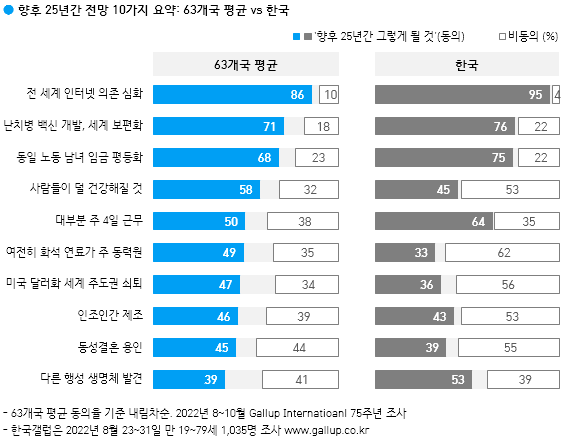
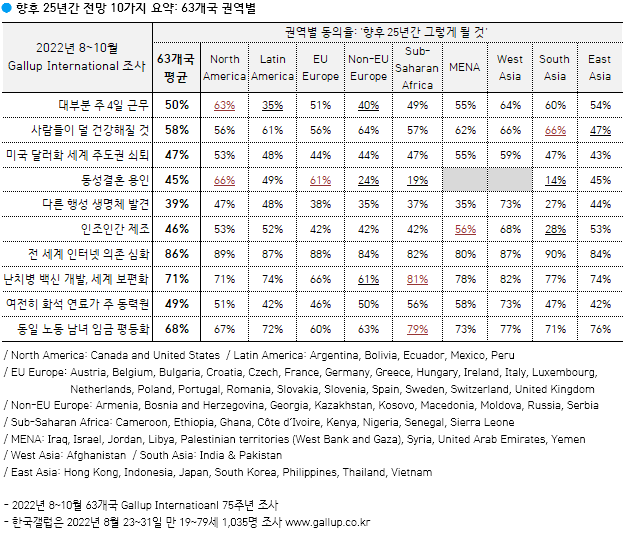
──
대부분 주 4일 근무
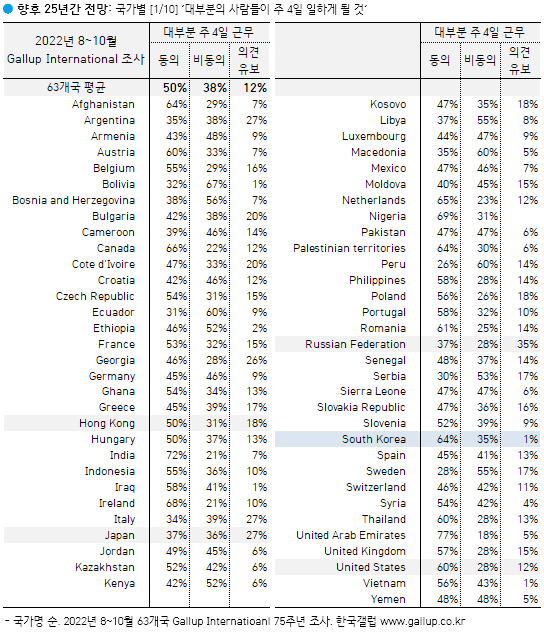
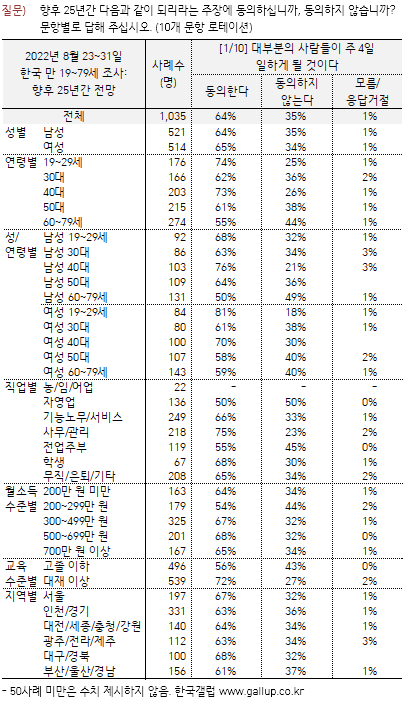
──
사람들이 덜 건강해질 것
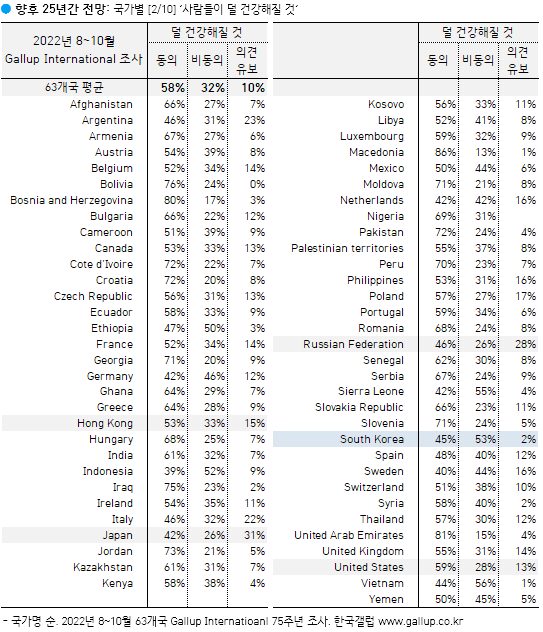
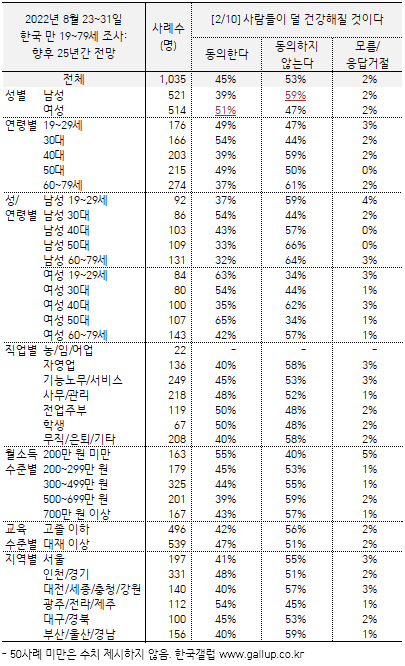
──
미국 달러화 세계 주도권 쇠퇴
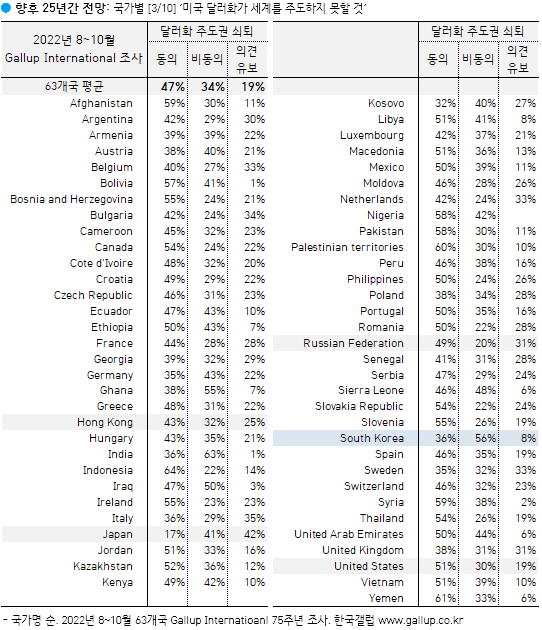
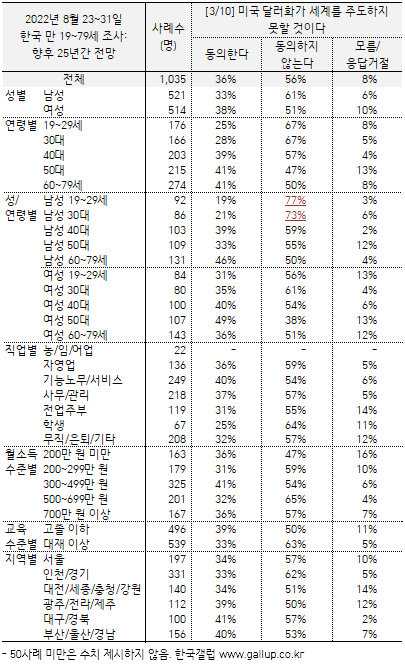
──
동성결혼 용인
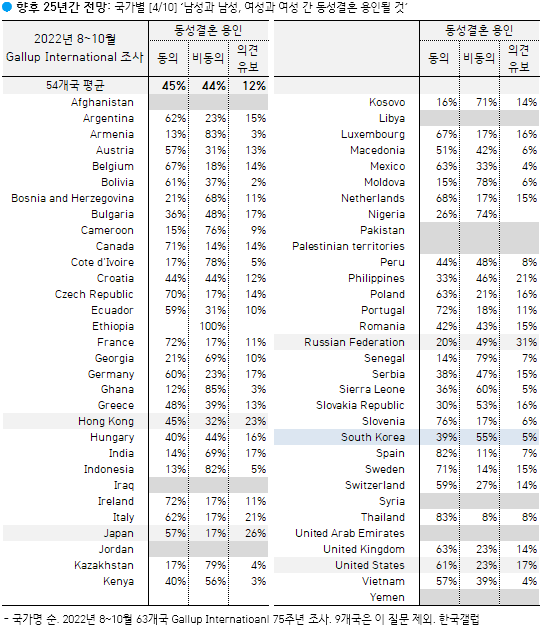
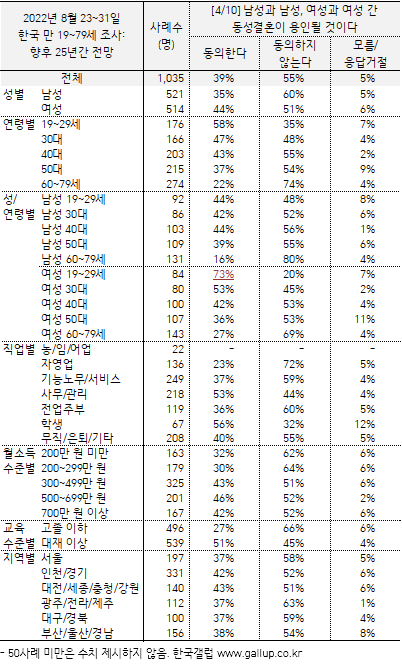
──
다른 행성 생명체 발견
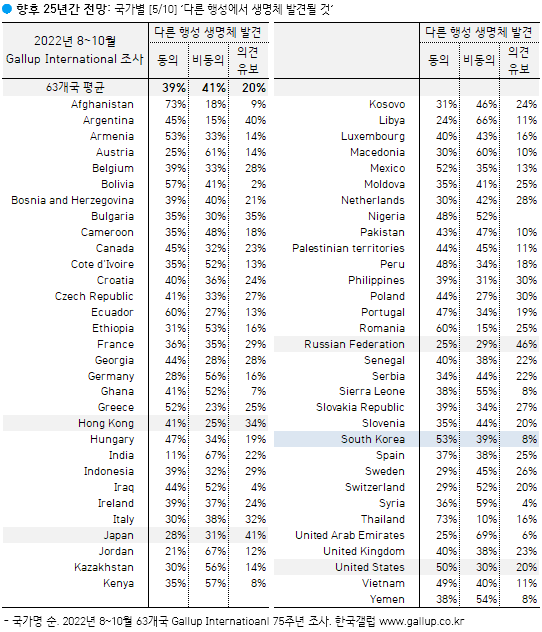
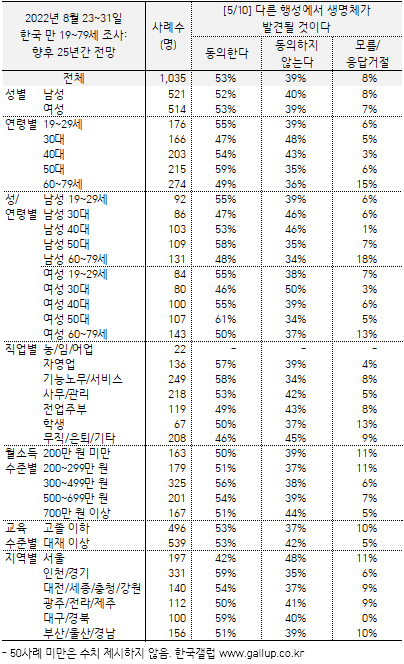
──
인조인간 제조
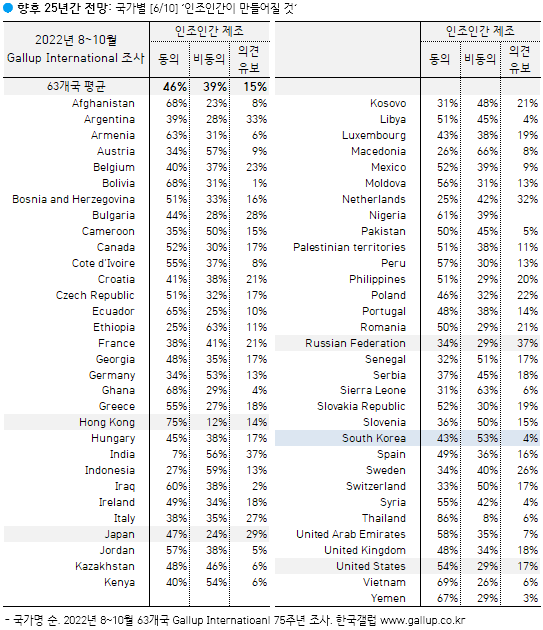
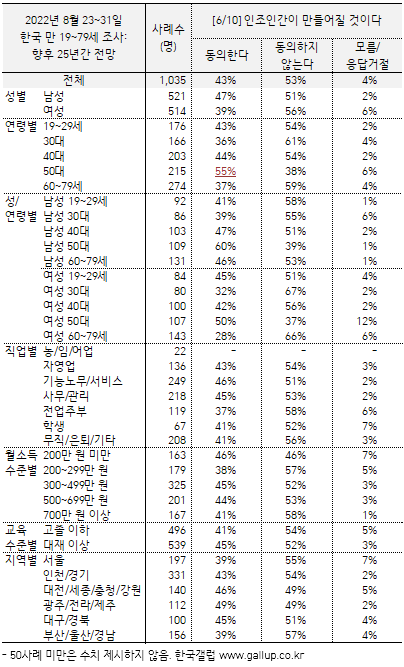
──
전 세계 인터넷 의존 심화
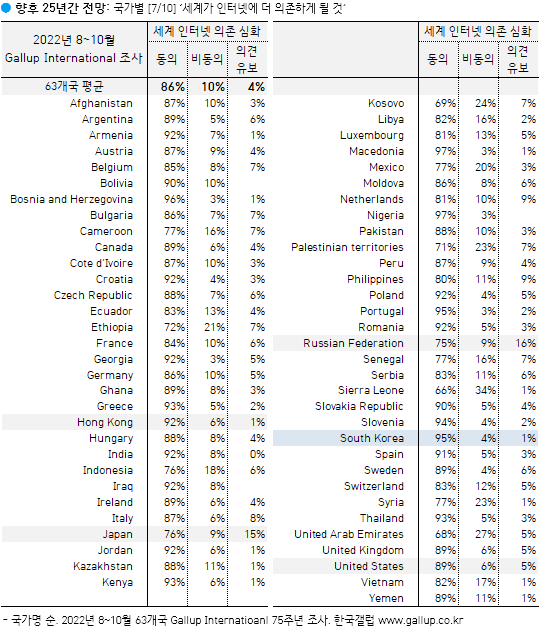
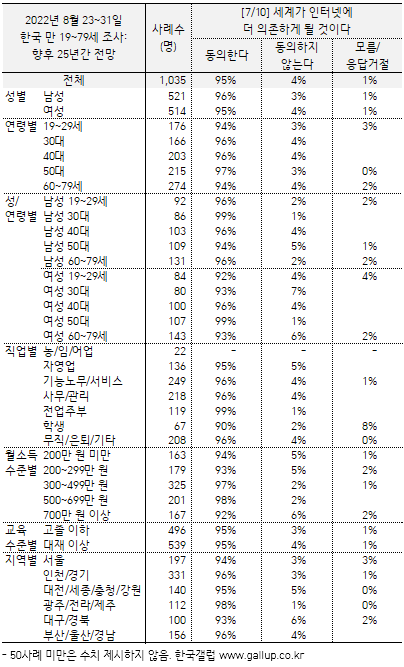
──
난치병 백신 개발, 세계 보편화
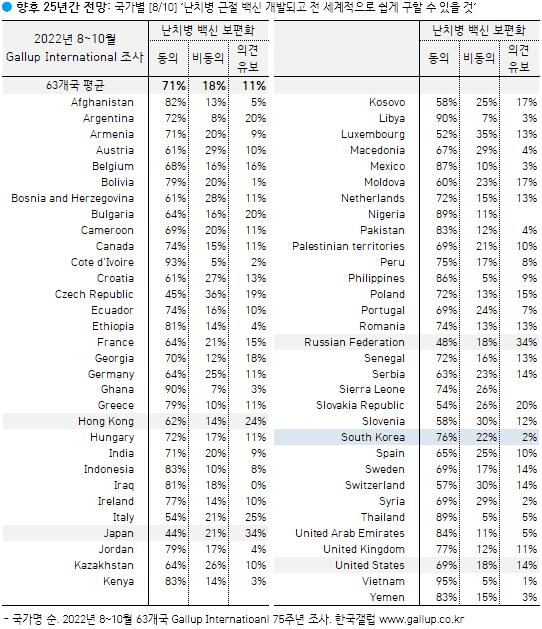
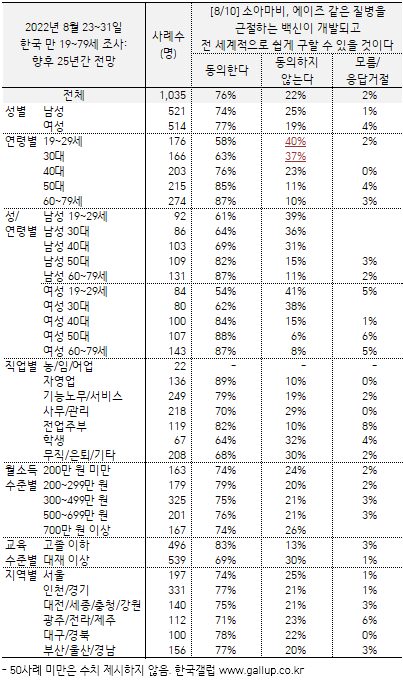
──
여전히 화석 연료가 주 동력원
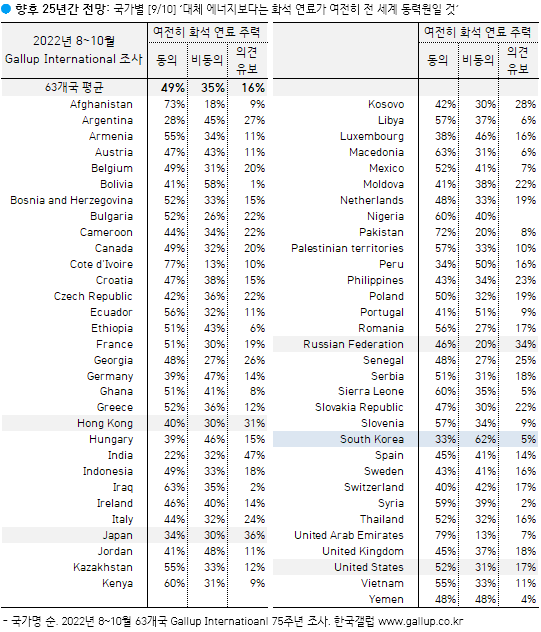
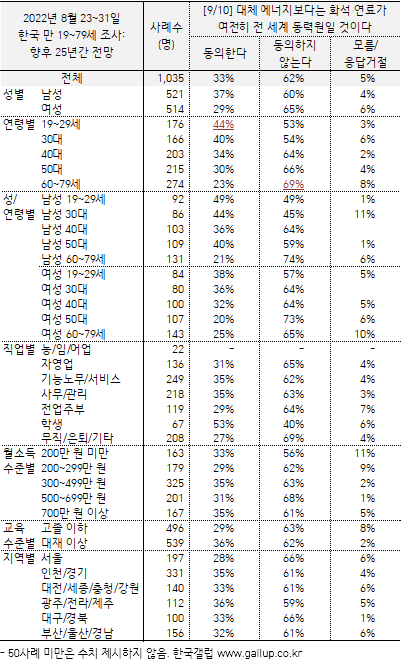
──
동일 노동 남녀 임금 평등화
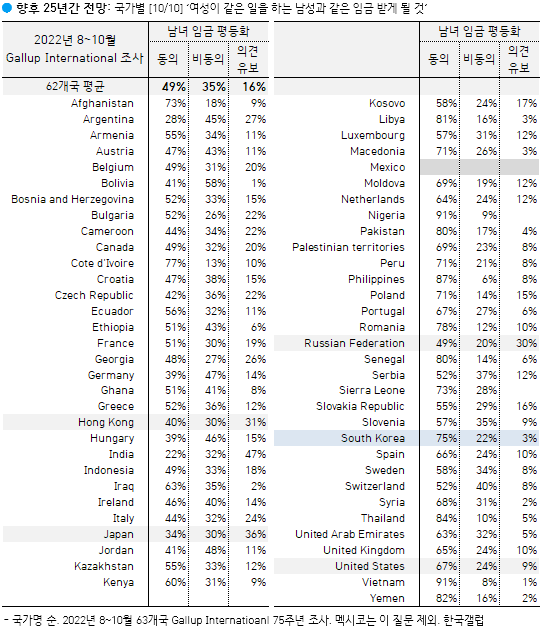
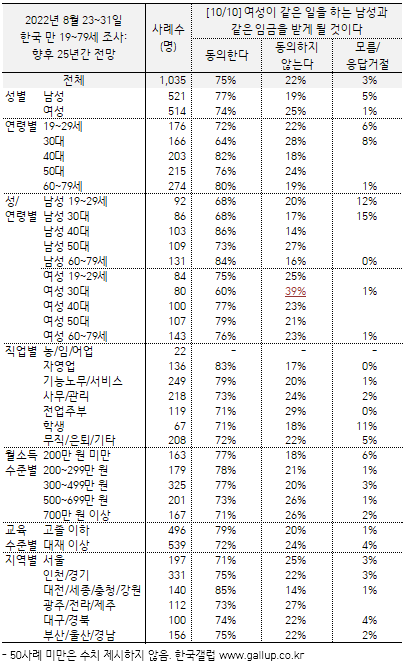
──────────────────
What will change in quarter of a century?
Ten expectations about the future tell us more about the present.
──────────────────
How much and what will change in the next 25 years? What are our expectations about the economy, technology, medicine? Will we obtain new rights, or will we lose some? When will we find life beyond Earth? The Global Association “Gallup International” (GIA) asked these and other questions about the foreseeable future. What world do we imagine – is it very different from our lives today?
Most people seem to agree that in the next 25 years a 4-day working week will be the norm around the world. The common perception however is that people will become less healthy in the next quarter of a century. The dollar will not be the world’s leading currency – according to near a half of the respondents worldwide. Same sex marriage will continue to divide opinion. Soon artificial human will be created – think 46% of respondents in different nations around the world. And there is great hope in the advancement of vaccines.
These are some of the highlights from the 75 years jubilee poll conducted by Gallup International Association (GIA), covering about two thirds of the global population (and more than 90% of those countries which are free to conduct and publish opinion research). The poll celebrates GIA’s 75th anniversary.
Healthier life and medical technology
More than a half (58%) of the global population agrees that over the next 25 years people will actually become less healthy. A third disagrees while 10% are undecided. The regions that agree to a lesser extent are East Asia and Oceania, EU Europe and North America, whereas the rest of the Asia region is among the regions agreeing the most. Attitudes are often a reflection of a variety of circumstances, like people’s views on the current quality of life, orientations towards healthy habits and their national healthcare systems and life standards.
People in countries like North Macedonia, for example, UAE, Bosnia and Herzegovina, Bolivia, Iraq, etc. seem most confident that humanity will become less healthy – 70-80%+. Least prone to agree with such a statement seem people in states like Indonesia, Sweden, Germany, the Netherlands, Sierra Leone, etc. with shares of only around 40%.
People around the world however agree that relatively soon there will be vaccines that will help in eradicating diseases that are currently hard to cure. 71% of respondents asked are positive that over the next 25 years vaccines are going to be available to eradicate diseases such as polio and AIDS. 18% of the respondents disagree and just over a tenth are still unsure. The European regions tend to be a bit more sceptical to that statement than other regions surveyed. In Europe there is also a noticeably higher share of indecisive respondents. Low-income economies seem more hopeful on this matter than wealthier countries. Perhaps there is more hope, where it is more needed – as low-income economies are disproportionately impacted by these diseases.
People in countries like Vietnam, Cote d'Ivoire, Ghana, Thailand and Philippines stand out with shares up to 80-90% as most prone to believe that soon there will be available vaccines to eradicate diseases that are hard to cure. Most doubtful seem people in Japan, Czech Republic, Russian Federation, Luxemburg and Italy.
What is right and what is a right
Most people agree that in the next 25 years a 4-dayworking week will be the norm around the world. 50% of the respondents in the GIA’s Global Survey say that the majority of us will start working 4 days a week only within the next couple of decades. 38% are rather doubtful and 12% refuse or do not know. People in North America, South Asia, MENA, East Asia/Oceania and the EU are more confident that a 4-working day week will be available for most people over the next 25 years. Latin America and non-EU Europe, followed by Sub-Saharan countries tend to agree less than other regions. The region with the highest share of answers “Do not know” is non-EU Europe, where almost one fifth cannot take a stand. The statement also shows visible (although not dramatic) differences in responses by personal income and education – those with higher education and income are more likely to expect a shorter working week in the future.
Confidence in a 4-day working week is considered most likely in UAE, India, Ireland and Canada with shares of agreement up to 70%. Citizens of Peru, Sweden, Ecuador and Italy for example are much more doubtful.
Same sex marriage as a right clearly divides the world in two halves. 45% of the respondents around the world think that over the next quarter of a century same sex marriage will be a recognised right. Yet 44% disagree. The rest cannot tell. It should be noted that the statement was not tested in MENA and West Asia, including Afghanistan, Iraq, Israel, Jordan, Libya, Palestinian territories (West Bank and Gaza), Syria, United Arab Emirates and Yemen. The regions agreeing with this statement are primarily North America and EU Europe, and the regions disagreeing the most are South Asia and Sub-Saharan countries, followed by non-EU Europe. Age seems not to be among the defining characteristics in terms of attitudes towards same sex marriage. Income and education however are – visibly more people with higher income and education expect that in 25 years same sex couples’ marriage will be considered right. Most defining drivers of opinion on this issue, of course, are religion, different cultural backgrounds and national characteristics/traditions.
Thailand, Spain, Slovenia, Ireland and France are among the top countries to believe this statement. On the opposite side stand out countries like Armenia, Indonesia and India and Senegal with much smaller shares of agreement.
There are slightly more people around the world believing that in the next 25 years polio and AIDS will be eradicated than people who believe women will receive the same payment as men for the same job done. 68% of respondents asked agree that in the foreseeable future women will be paid equally. 23% however disagree and 9% cannot say. Interestingly, Europeans (both countries in EU and non-EU countries) and respondents in North America appear a bit more sceptical and indecisive, but even there the share of those who expect equal payment for men and women for the same job is near two thirds. Most confident in equal payment in the future seem to be people in Sub-Saharan Africa, West Asia and East Asia/Oceania. Younger generations, people with higher income and people with higher education are more confident that men and women will soon have equal wages. Country-wise however most optimistic are low-income countries, while high income nations seem more hesitant. And women themselves are a bit less optimistic for equal payment.
People in Nigeria, Vietnam, Philippines, Cote d'Ivoire etc. seem most convinced that women will be paid equal as men. Least prone to believe in this seem people in Austria, Germany, Japan, Russia and others.
Economy
Almost half of the people in different nations around the world feel that the US dollar will lose its role as the world’s leading currency over the next 25 years. 34% are of the opposite opinion while 19% are unsure. The statement is agreed with primarily in West Asia, followed by MENA. Worth noting is the fact that 53% in North America agree with this statement, whereas one fifth are undecided. In both EU and non-EU countries the share of those who expect that the dollar will no longer be world’s leading currency is near a half of all respondents.
Some of the top countries to agree with this statement are Indonesia, Yemen, Palestinian territories, Syria and Afghanistan. People from Japan, Kosovo, Germany, Sweden etc. seem the least convinced.
Half of the people worldwide believe that in 25 years fossil fuels will still power the world, rather than alternative energy sources. 35% do not agree. 16% unsure. West Asia appears most convinced by the role of fossil fuels – with more than 7 in 10 agreeing that fossil fuels will remain the main energy source. Latin America is the most sceptical region, where more than 4 out of 10 disagree with the statement. It seems that the EU, with its green transition, has not been able to fully convince its citizens – 46% say that fossil fuels will remain leading in the near future while37% disagree. Low-income economies as a whole seem more likely to say that fossil fuels will preserve their place in our lives over the next 25 years.
Most people agreeing with this statement are in UAE, Cote d'Ivoire, Afghanistan, Pakistan, etc. The Lowest shares of agreement is registered for instance in countries like India, Argentina, South Korea, Japan and Peru.
Beyond humanity…
As technology is progressing the internet becomes more and more essential in our lives. 86% of the people asked agree that the world will become even more dependent on the internet, which makes this statement the one that almost everybody agrees upon. The difference in opinions on this issue are not geographically defined, rather more demographic. Low-income countries, for instance, think to a lesser extent that we will become even more dependent on the internet over the next 25 years – 77%. So do the less educated people all over the world.
“An artificial human will be created” in the next quarter of a century believe 46% of our global survey participants, 39% disagree and 15% cannot tell. West Asia (Afghanistan) tends to agree to a much higher extent than other regions. Approximately one fifth in the European regions and in East Asia + Oceania are still undecided.
The same pattern is to be seen for the statement “Life will be found on another planet” – also for this question West Asia tend to be more positive. 39% worldwide agree and 41% are on the opposite opinion. 20% cannot tell.
Both statements gain relatively more support from younger generations. Religious beliefs also correlate with opinions towards extra-terrestrial life and creating artificial humans.
Kancho Stoychev,
President of Gallup International Association:
“The changes that are anticipated are not always the ones that arrive. And vice versa. A look into Roper Center data base shows that when in 1949 Americans were asked whether they expected man to reach the moon in the next fifty years, only 15% said yes. Just 20 years later the footprint of humanity was already there.
In contrast, the public has been all too willing to believe that a cure for cancer is imminent. The strong majorities that anticipated a cure well before the end of the 20th century were disappointed, though great advancements in treatment and life expectancy were made.
And a 1998 Gallup Inc. poll found that 61% of Americans thought that within just twenty-five years, most people would routinely live to 100 years. A quarter of century later we are still far away… maybe.
Expectations for the future are at least an essential part of the picture of the present mass public attitudes. The fact that practically everyone on the Planet is convinced that in the next 25 years our dependence on internet will grow means that we are already too much dependent on it. And when our opinions on the future of some issues are strongly divided that means that the controversy is not in front of us but already is in our everyday life. The four days working week looks behind the corner for the people living in the developed world but they might be pretty well surprised by zero working days – the guaranteed income is on the same street and maybe closer than we expect.”
──
한국 응답자 특성표
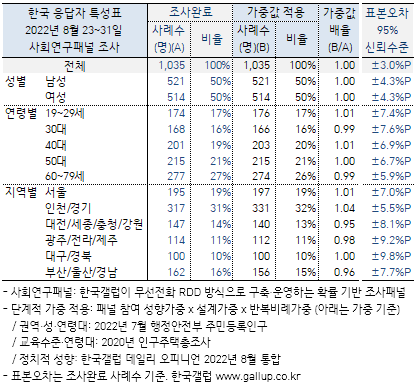
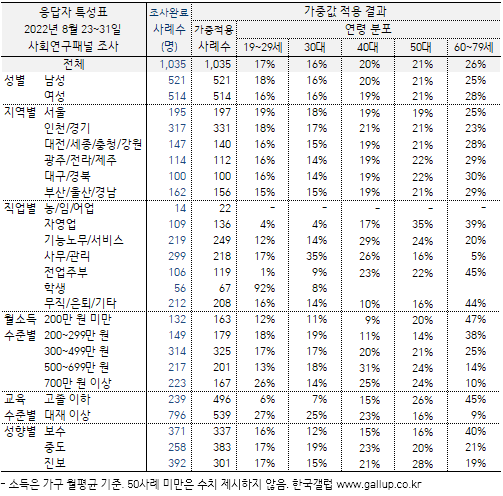
| 1947년 조지 갤럽 박사가 설립한 갤럽 인터내셔널(Gallup International Association)은 매년 전 세계 회원사 공동으로 주요 현안에 관한 여론을 조사합니다. 2022년 가을에는 설립 75주년을 기념하는 조사를 했고, 올해 상반기 몇 차례에 걸쳐 그 결과를 전하고 있습니다. 지난번 〈경제·안보 전략적 파트너〉 〈현세대 삶 평가, 다음 세대 삶 전망〉 〈국외 이주 의향〉에 이어, 오늘은 향후 25년간 전망 10가지를 알려드립니다. → Press release for the 120th Anniversary of Dr. George Gallup |
향후 25년간 전망 10가지 - Gallup International 75주년 다국가 조사
→ 한국+세계 조사 결과 파일 다운로드(PDF)
/ 세계 조사 개요
- 2022년 8~10월 63개국 성인 총 59,716명 전화/온라인/면접조사(주제별 참여국 상이)
/ 한국 조사 개요
- 조사기간: 2022년 8월 23~31일
- 표본추출: 사회연구패널★에서 성·연령·지역별 층화 추출
(한국갤럽이 무선전화 RDD 방식으로 구축·운영하는 확률 기반 조사패널)
- 응답방식: 모바일조사(조사대상자에게 문자메시지 발송, 자기기입식 웹조사)
- 조사대상: 전국 만 19~79세 1,035명
- 표본오차: ±3.0%포인트(95% 신뢰수준)
- 문자 발송 대비 응답 완료율: 46%(총 2,263명 중 1,035명)
- 의뢰처: 한국갤럽-Gallup International 자체 조사
/ 문항(순서 로테이션 질문, 화살표(→) 옆 단어 클릭하면 해당 집계표로 이동)
향후 25년간 다음과 같이 되리라는 주장에 동의하십니까, 동의하지 않습니까?
→ 대부분 주 4일 근무
→ 사람들이 덜 건강해질 것
→ 미국 달러화 세계 주도권 쇠퇴
→ 동성결혼 용인
→ 다른 행성 생명체 발견
→ 인조인간 제조
→ 전 세계 인터넷 의존 심화
→ 난치병 백신 개발, 세계 보편화
→ 여전히 화석 연료가 주 동력원
→ 동일 노동 남녀 임금 평등화
조사 결과
2022년 8~10월 63개국 시민 86%, '향후 25년간 세계가 인터넷에 더 의존하게 될 것'
- '난치병 백신 개발·보편화', '동일 노동 남녀 임금 평등화' 동의율 70% 내외
- 절반가량 '주 4일 근무' 낙관, '미국 달러화 세계 주도권 쇠퇴' 예상
- '인조인간 제조', '동성결혼 용인', '다른 행성 생명체 발견'에는 전망 엇갈려
갤럽 인터내셔널이 2022년 8~10월 63개국 시민 59,716명에게 인류의 건강·기술·경제·인권 등 10가지 일들이 향후 25년간 실현될 것 같은지, 그렇지 않은지 각각 물었다(문항 로테이션, 동의:비동의 2점 척도). 그 결과 63개국 시민 86%가 향후 25년간 '세계가 인터넷에 더 의존하게 될 것'이라고 내다봤고(:비동의 10%), '소아마비, 에이즈 같은 질병 근절 백신이 개발되고, 전 세계적으로 쉽게 구할 수 있게 될 것'이라는 데 71%(:18%), '주 4일 근무' 실현에는 50%가 동의했다(:38%).
하지만, 난치병 극복이나 주 4일 근무 실현이 건강 향상 기여 핵심 요인은 아닌 듯하다. 58%가 '사람들이 덜 건강해질 것', 즉 나빠질 것이라고 예상했다(:32%). 건강 관련 태도에는 삶의 질에 관한 사회적 인식, 문화적 습관, 국가 의료 시스템 등 다양한 배경이 복합 반영되는 것으로 보인다.
◎ 향후 25년간 '대체 에너지보다 화석 연료가 여전히 전 세계 동력원일 것'이라고 보는 사람이 49%(비동의 35%), '미국 달러화가 세계를 주도하지 못하게 될 것'이라는 데는 47%가 동의했다(:34%). 미국 달러화 주도권 쇠퇴에는 MENA(중동·북아프리카, 55%)·북미(53%) 국가 동의율이 높고, 동아시아(43%) 지역에서 상대적으로 낮은 편이다.
화석 연료 지배력이 유지되리라는 믿음은 산유국이 많은 MENA(58%)에서 강한 편, 중남미·동아시아(각각 42%)에서는 상대적으로 회의적이다. EU는 친환경 에너지로의 전환에 적극적이지만, 시민들을 완전히 설득하지는 못한 것으로 보인다. EU 시민 46%가 앞으로도 화석 연료가 주로 쓰일 것, 37%가 그렇지 않을 것이라고 답했다.
◎ 한편 향후 25년간 '남성과 남성, 여성과 여성 간 동성결혼이 용인될 것'이라는 데는 동의 45%, 비동의 44%로 팽팽하게 맞섰고, 과학기술 분야의 오랜 꿈인 '인조인간 제조'(46%:39%)와 '다른 행성 생명체 발견'(39%:41%) 전망에서도 가부가 비등하게 갈렸다.
동성결혼이 용인되리라는 예상은 북미(66%)와 EU(61%) 지역에서 두드러지며, 남아시아(14%)·사하라 이남 아프리카(19%)에서 가장 적었다. 조사 참여국 전체적으로 보면 동성결혼에 대한 전망에서 나이는 결정적 변인이 아니다. 고소득·고학력일수록 동성결혼에 전향적이며, 무엇보다 국가별 종교적·문화적 배경과 전통에 따른 차이가 가장 큰 것으로 보인다. 예컨대, MENA 등 일부 국가에서는 조사 진행 시 이런 질문 자체가 용인되지 않는다.
──
한국인 75% '향후 25년간 '동일 노동 남녀 임금 평등화',
'주 4일 근무' 낙관 64%, '다른 행성 생명체 발견' 53%: 63개국 평균 상회
- 미국 달러화 위력 지속, 대체 에너지 활성화 믿음 강한 편
한국 조사는 2022년 8월 23~31일 전국 만 19~79세 1,035명을 대상으로 했다. 한국인 중 95%가 '향후 25년간 전 세계 인터넷 의존 심화'를 예상했고, 76%는 '난치병 백신 개발·보편화'될 것이라 봤다. '동일 노동 남녀 임금 평등화'(75%), '주 4일 근무'(64%), '다른 행성 생명체 발견'(53%)에 대한 동의율은 63개국 평균을 웃돌았고, '앞으로도 화석 연료가 주로 쓰일 것'(33%)이라거나 '미국 달러화의 세계 주도권이 쇠퇴할 것'(36%)이라는 주장에는 상대적으로 동의율이 낮았다. 다시 말해 한국인은 미국 달러화 위력 지속, 대체 에너지 활성화에 대한 믿음이 강한 편이라고 볼 수 있다.
◎ 향후 25년간 '사람들이 덜 건강해질 것'(동의 45%:비동의 53%), '인조인간 제조'(43%:53%), '동성결혼 용인'(39%:55%) 등의 가능성에 대해서도 한국인은 63개국 평균보다 동의하지 않는다는 응답이 많았다. 단, 이 결과는 각각의 사안에 관한 개인의 찬반이나 옳고 그른 판단이 아니라 앞으로 그렇게 될 것 같은지 물었다는 점에 주의해야 한다. 참고로, 2021년 조사에서 한국인 58%는 '동성애도 사랑의 한 형태'라고 봤으며, 38%가 동성결혼 법제화에 찬성했다(20대 73%; 60대 이상 17%)(→ 데일리 제448호).


──
대부분 주 4일 근무


──
사람들이 덜 건강해질 것


──
미국 달러화 세계 주도권 쇠퇴


──
동성결혼 용인


──
다른 행성 생명체 발견


──
인조인간 제조


──
전 세계 인터넷 의존 심화


──
난치병 백신 개발, 세계 보편화


──
여전히 화석 연료가 주 동력원


──
동일 노동 남녀 임금 평등화


──────────────────
What will change in quarter of a century?
Ten expectations about the future tell us more about the present.
──────────────────
How much and what will change in the next 25 years? What are our expectations about the economy, technology, medicine? Will we obtain new rights, or will we lose some? When will we find life beyond Earth? The Global Association “Gallup International” (GIA) asked these and other questions about the foreseeable future. What world do we imagine – is it very different from our lives today?
Most people seem to agree that in the next 25 years a 4-day working week will be the norm around the world. The common perception however is that people will become less healthy in the next quarter of a century. The dollar will not be the world’s leading currency – according to near a half of the respondents worldwide. Same sex marriage will continue to divide opinion. Soon artificial human will be created – think 46% of respondents in different nations around the world. And there is great hope in the advancement of vaccines.
These are some of the highlights from the 75 years jubilee poll conducted by Gallup International Association (GIA), covering about two thirds of the global population (and more than 90% of those countries which are free to conduct and publish opinion research). The poll celebrates GIA’s 75th anniversary.
Healthier life and medical technology
More than a half (58%) of the global population agrees that over the next 25 years people will actually become less healthy. A third disagrees while 10% are undecided. The regions that agree to a lesser extent are East Asia and Oceania, EU Europe and North America, whereas the rest of the Asia region is among the regions agreeing the most. Attitudes are often a reflection of a variety of circumstances, like people’s views on the current quality of life, orientations towards healthy habits and their national healthcare systems and life standards.
People in countries like North Macedonia, for example, UAE, Bosnia and Herzegovina, Bolivia, Iraq, etc. seem most confident that humanity will become less healthy – 70-80%+. Least prone to agree with such a statement seem people in states like Indonesia, Sweden, Germany, the Netherlands, Sierra Leone, etc. with shares of only around 40%.
People around the world however agree that relatively soon there will be vaccines that will help in eradicating diseases that are currently hard to cure. 71% of respondents asked are positive that over the next 25 years vaccines are going to be available to eradicate diseases such as polio and AIDS. 18% of the respondents disagree and just over a tenth are still unsure. The European regions tend to be a bit more sceptical to that statement than other regions surveyed. In Europe there is also a noticeably higher share of indecisive respondents. Low-income economies seem more hopeful on this matter than wealthier countries. Perhaps there is more hope, where it is more needed – as low-income economies are disproportionately impacted by these diseases.
People in countries like Vietnam, Cote d'Ivoire, Ghana, Thailand and Philippines stand out with shares up to 80-90% as most prone to believe that soon there will be available vaccines to eradicate diseases that are hard to cure. Most doubtful seem people in Japan, Czech Republic, Russian Federation, Luxemburg and Italy.
What is right and what is a right
Most people agree that in the next 25 years a 4-dayworking week will be the norm around the world. 50% of the respondents in the GIA’s Global Survey say that the majority of us will start working 4 days a week only within the next couple of decades. 38% are rather doubtful and 12% refuse or do not know. People in North America, South Asia, MENA, East Asia/Oceania and the EU are more confident that a 4-working day week will be available for most people over the next 25 years. Latin America and non-EU Europe, followed by Sub-Saharan countries tend to agree less than other regions. The region with the highest share of answers “Do not know” is non-EU Europe, where almost one fifth cannot take a stand. The statement also shows visible (although not dramatic) differences in responses by personal income and education – those with higher education and income are more likely to expect a shorter working week in the future.
Confidence in a 4-day working week is considered most likely in UAE, India, Ireland and Canada with shares of agreement up to 70%. Citizens of Peru, Sweden, Ecuador and Italy for example are much more doubtful.
Same sex marriage as a right clearly divides the world in two halves. 45% of the respondents around the world think that over the next quarter of a century same sex marriage will be a recognised right. Yet 44% disagree. The rest cannot tell. It should be noted that the statement was not tested in MENA and West Asia, including Afghanistan, Iraq, Israel, Jordan, Libya, Palestinian territories (West Bank and Gaza), Syria, United Arab Emirates and Yemen. The regions agreeing with this statement are primarily North America and EU Europe, and the regions disagreeing the most are South Asia and Sub-Saharan countries, followed by non-EU Europe. Age seems not to be among the defining characteristics in terms of attitudes towards same sex marriage. Income and education however are – visibly more people with higher income and education expect that in 25 years same sex couples’ marriage will be considered right. Most defining drivers of opinion on this issue, of course, are religion, different cultural backgrounds and national characteristics/traditions.
Thailand, Spain, Slovenia, Ireland and France are among the top countries to believe this statement. On the opposite side stand out countries like Armenia, Indonesia and India and Senegal with much smaller shares of agreement.
There are slightly more people around the world believing that in the next 25 years polio and AIDS will be eradicated than people who believe women will receive the same payment as men for the same job done. 68% of respondents asked agree that in the foreseeable future women will be paid equally. 23% however disagree and 9% cannot say. Interestingly, Europeans (both countries in EU and non-EU countries) and respondents in North America appear a bit more sceptical and indecisive, but even there the share of those who expect equal payment for men and women for the same job is near two thirds. Most confident in equal payment in the future seem to be people in Sub-Saharan Africa, West Asia and East Asia/Oceania. Younger generations, people with higher income and people with higher education are more confident that men and women will soon have equal wages. Country-wise however most optimistic are low-income countries, while high income nations seem more hesitant. And women themselves are a bit less optimistic for equal payment.
People in Nigeria, Vietnam, Philippines, Cote d'Ivoire etc. seem most convinced that women will be paid equal as men. Least prone to believe in this seem people in Austria, Germany, Japan, Russia and others.
Economy
Almost half of the people in different nations around the world feel that the US dollar will lose its role as the world’s leading currency over the next 25 years. 34% are of the opposite opinion while 19% are unsure. The statement is agreed with primarily in West Asia, followed by MENA. Worth noting is the fact that 53% in North America agree with this statement, whereas one fifth are undecided. In both EU and non-EU countries the share of those who expect that the dollar will no longer be world’s leading currency is near a half of all respondents.
Some of the top countries to agree with this statement are Indonesia, Yemen, Palestinian territories, Syria and Afghanistan. People from Japan, Kosovo, Germany, Sweden etc. seem the least convinced.
Half of the people worldwide believe that in 25 years fossil fuels will still power the world, rather than alternative energy sources. 35% do not agree. 16% unsure. West Asia appears most convinced by the role of fossil fuels – with more than 7 in 10 agreeing that fossil fuels will remain the main energy source. Latin America is the most sceptical region, where more than 4 out of 10 disagree with the statement. It seems that the EU, with its green transition, has not been able to fully convince its citizens – 46% say that fossil fuels will remain leading in the near future while37% disagree. Low-income economies as a whole seem more likely to say that fossil fuels will preserve their place in our lives over the next 25 years.
Most people agreeing with this statement are in UAE, Cote d'Ivoire, Afghanistan, Pakistan, etc. The Lowest shares of agreement is registered for instance in countries like India, Argentina, South Korea, Japan and Peru.
Beyond humanity…
As technology is progressing the internet becomes more and more essential in our lives. 86% of the people asked agree that the world will become even more dependent on the internet, which makes this statement the one that almost everybody agrees upon. The difference in opinions on this issue are not geographically defined, rather more demographic. Low-income countries, for instance, think to a lesser extent that we will become even more dependent on the internet over the next 25 years – 77%. So do the less educated people all over the world.
“An artificial human will be created” in the next quarter of a century believe 46% of our global survey participants, 39% disagree and 15% cannot tell. West Asia (Afghanistan) tends to agree to a much higher extent than other regions. Approximately one fifth in the European regions and in East Asia + Oceania are still undecided.
The same pattern is to be seen for the statement “Life will be found on another planet” – also for this question West Asia tend to be more positive. 39% worldwide agree and 41% are on the opposite opinion. 20% cannot tell.
Both statements gain relatively more support from younger generations. Religious beliefs also correlate with opinions towards extra-terrestrial life and creating artificial humans.
Kancho Stoychev,
President of Gallup International Association:
“The changes that are anticipated are not always the ones that arrive. And vice versa. A look into Roper Center data base shows that when in 1949 Americans were asked whether they expected man to reach the moon in the next fifty years, only 15% said yes. Just 20 years later the footprint of humanity was already there.
In contrast, the public has been all too willing to believe that a cure for cancer is imminent. The strong majorities that anticipated a cure well before the end of the 20th century were disappointed, though great advancements in treatment and life expectancy were made.
And a 1998 Gallup Inc. poll found that 61% of Americans thought that within just twenty-five years, most people would routinely live to 100 years. A quarter of century later we are still far away… maybe.
Expectations for the future are at least an essential part of the picture of the present mass public attitudes. The fact that practically everyone on the Planet is convinced that in the next 25 years our dependence on internet will grow means that we are already too much dependent on it. And when our opinions on the future of some issues are strongly divided that means that the controversy is not in front of us but already is in our everyday life. The four days working week looks behind the corner for the people living in the developed world but they might be pretty well surprised by zero working days – the guaranteed income is on the same street and maybe closer than we expect.”
──
한국 응답자 특성표

